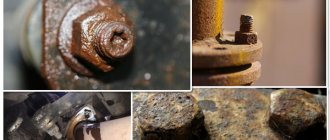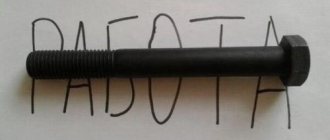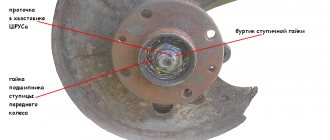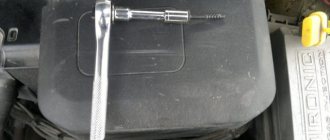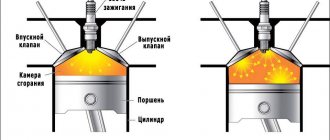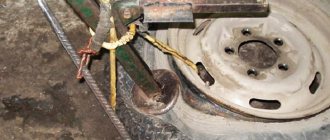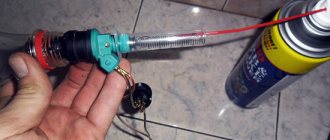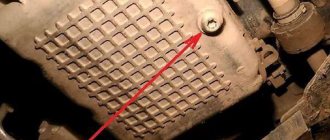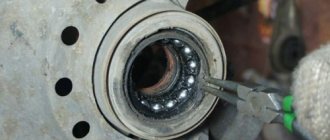How to unscrew a rusty nut at home
If a rusty nut cannot be unscrewed, do not get excited and try to rip it off - there are many effective ways to unscrew it without wasting effort.
The main reason for jamming of rusted joints is metal corrosion. During the process of metal rusting, the products of its oxidative reaction, or, more simply put, rust, increase many times in volume, tightly gripping together the parts connected by the threaded connection. The situation is further aggravated by the ingress of small particles of dust and dirt onto the threaded surfaces. Tool selection The success of unscrewing difficult-to-work threaded connections largely depends on the tool used. Do not try to unscrew a rusty nut using an open-end wrench. The weakness of the design of such a tool will lead to the fact that the jaws of the wrench will simply move apart and jump over the edge of the nut, and the short length of the tool will not allow the necessary force to be applied. In such a situation, it is better to opt for ring wrenches or use a set of sockets with a knob - both the edges of the nut and your hands will be intact. As for the integrity of the hands. To avoid injury, when unscrewing threaded connections in hard-to-reach places, applying force to the tool with your hand, you should avoid foreign objects in the direction of movement of the hand with the key or wrench. Dissolving rust If, despite the titanic efforts made, the nut still does not unscrew, you should not force the tool and exhaust yourself with excessive physical exertion. It is enough to moisten the rusted thread with a liquid that can partially dissolve the rust and thereby reduce the friction forces. The arsenal of such liquids is quite wide: from special rust converters and the well-known WD-40 to gasoline, diesel fuel, kerosene, turpentine and brake fluid. By the way, ordinary table vinegar and an alcohol solution of iodine from a car first aid kit have an effective effect on rust. In extreme cases, even Coca-Cola containing phosphoric acid will do. Having generously moistened the rusty connection and waited from 10 minutes to half an hour, you can pick up the tool and try to unscrew the stubborn nut. If even after this the thread does not give in, and time allows, it is advisable to wrap the threaded connection with a napkin soaked in one of the listed liquids and leave it for an hour or two. Most of the nuts unscrew slowly after this procedure, especially if you work on them by working the tool back and forth, that is, rocking. Instead of unscrewing, twisting is an original and very useful method that allows you to destroy a layer of rust, using a slight tightening of the nut instead of unscrewing. After the nut moves at least a little in the direction of tightening, it, although tightly, will begin to turn out. Tapping the edges For this procedure you will need a small 100 gram hammer. Applying light blows with a hammer to the faces of the nut, you should alternately move from one face to another in a circle. Microcracks that appear during the tapping process will slowly but inevitably lead to deformation and destruction of rust. The main thing is to avoid strong blows with a hammer, which can damage the edges of the nut, bend the bolt, or even destroy the part held together by them. Heating Using a heat source (gas torch, blowtorch, lighter, match, candle, soldering iron, hair dryer or ordinary boiling water), you need to heat the nut, being careful not to heat up the bolt or stud on which it sits. When heated, the nut will expand and increase in volume, becoming several microns wider than the bolt, which will greatly facilitate the process of unscrewing it. In addition, due to uneven heating, the layer of rust on the threaded connection will collapse and lose its former strength. Be extremely careful when working with open flames and heating devices! Destruction This method is undesirable, but in some cases it is sometimes the only one that can solve the problem of rusted threaded connections. Armed with a hammer and a sharp chisel, you need to punch grooves on the edges of the stubborn nut. Uniform insertion of the chisel from all sides will lead to its deformation and increase in internal diameter, which will allow you to unscrew it from the thread without much effort. In the end, the threaded connection can be destroyed by sawing the bolt with a grinder or a hacksaw, the nut can be knocked off by cutting the bolt with a sharp chisel, it can be sawed in half along the axis of the bolt, and you can also try to drill it out using an electric drill. In all these cases, the nut and bolt will be hopelessly damaged upon completion of the work.
Vinegar
A rusty bolt or nut that does not want to be unscrewed can be brought back to obedience by table vinegar. To do this, wet the area of the threaded connection with vinegar and wait 15 to 30 minutes. If time is not limited, then you can simply cover the fasteners with a rag soaked in vinegar. In a couple of hours, vinegar will thoroughly undermine the rust and weaken the adhesion of the mating surfaces in the fasteners. After such a “compress”, the rusty bolt or nut will at first reluctantly, and then become easier and easier to unscrew.
Effective ways to unscrew a rusty bolt or nut?
If we consider more effective ways to combat rust, it is worth highlighting the following methods.
Heat.
From the physics course we know that metal tends to expand as temperature increases. This feature can be used to solve the problem.
To unscrew a rusty nut, warm it up thoroughly, and then immediately try to unscrew it.
It is important to act quickly here so that the metal product does not have time to cool down. The essence of the manipulation is that due to uneven heating, the rust is deformed and has less restraining force. Heating can be carried out in any available way
This could be a gas burner, a candle, a lighter or even a soldering iron.
Heating can be carried out in any available way. This could be a gas burner, a candle, a lighter, or even a soldering iron.
You can also use a blowtorch or other device.
When using this technique, be careful and remember the contraindications. In particular, heating is not recommended if wood or paintwork products are located in the joint area.
In this case, the part will be damaged and you will have to spend money on replacing it.
Tapping.
You can unscrew a rusty nut or bolt using the traditional method - by tapping around the perimeter of the part.
Mechanical impact on each side allows for greater deformation, which contributes to the scattering of rust.
While tapping, be careful not to damage the edges of the nut. Otherwise, the task of twisting will become more difficult. Spin
Twist.
You can also go the other way. First, tighten the nut (bolt) with maximum force, and then try to rock the connection and dislodge the rust layer in this way.
If the manipulation is successful, unscrewing the nut or bolt will not be difficult.
Wax cup (difficult, not practical, but possible).
This technique cannot be called popular, but in terms of effectiveness it is in no way behind its “competitors”.
The algorithm of actions is simple. Make a cup-shaped shape from plasticine or wax so that its sides are above the level of the nut (about 2-3 mm).
Then dilute the sulfuric acid, pour the liquid into the prepared cup and add a little zinc. This chemical combination provides a galvanic effect and the ability to unscrew the part.
Destruction.
If none of the above methods produces results, and the upper part is broken or severely deformed, there is another solution - breaking the bolt and drilling it out of the vehicle part.
Here, to complete the work you will need a hand or electric tool, as well as a set of drills of a suitable diameter.
Before drilling, place the drill bit in the center of the bolt and hit it with a hammer. This is necessary to deepen the product in the central part to a certain depth.
First, work in small increments and make sure that the drill enters exactly in the central part (tilts to the left and right are prohibited).
Start with a small diameter drill and then move on to a larger piece.
When choosing a drill, pay attention to two criteria - price and country of origin. Please note that high quality products cannot be cheap, because they are made from hardened steel and sharpened in a certain way. Please note that high quality products cannot be cheap, because they are made from hardened steel and sharpened in a certain way.
Please note that high quality products cannot be cheap, because they are made from hardened steel and sharpened in a certain way.
At the same time, special drills do an excellent job with aluminum, cast iron and other materials (including brittle ones).
To ensure correct drilling, use special lubricants, which can solve several problems at once - protect the drill from strong heat, cool the metal and lubricate the drilling elements. As a result, the whole process becomes easier.
Effective ways to remove a broken bolt from an engine block
Not only will the bolts become loose, but they may also be over-tightened or mis-threaded. This may not have any effect on operation, but the next time you disassemble the connection, it will be difficult to unscrew the hardware. You have to put in a lot of effort. Because of this, the following consequences arise:
- the thread breaks;
- fasteners crack;
- the hat breaks off.
For one or more reasons, the fastener cannot be unscrewed from the seat in the usual way.
If we are talking about the cylinder head, then a large tightening torque is used here, which is why the above consequences arise. Before unscrewing a broken bolt, you need to perform preparatory measures:
Clean the hardware itself and the area around it from accumulated oil, rust, and dirt using a wire brush and solvent. The joint should then be further treated with a penetrating compound such as WD-40, brake fluid or clean engine oil. Thanks to this procedure, the bolts should loosen.
If the bolt breaks above the threaded surface
This case is considered easy, because the protruding pin means that the bolt has been unscrewed at least a little, and this also allows the use of clamping tools, as well as other manipulations to unscrew the fragment with a screwdriver or using a rod.
- To break up the rust and tear off the hardware, it is recommended to first tap the fastener with a hammer through the extension and heat it with an induction bolt heater or a blowtorch. The spinning pin is unscrewed using pliers, an adjustable wrench or other similar tool. When tapping, you should not use much force, because you can break the threads in the hole or damage other parts.
- Using a hacksaw or grinder, slots are also cut into the fragment for a flat or Phillips screwdriver, and then unscrew it.
- If the fragment protrudes above the surface to a sufficient height, then a through transverse hole can be drilled in the body, into which a thick long nail, a metal rod or even a screwdriver is then inserted. The protruding parts of the tool at hand will not only allow you to influence the rest of the bolt, but will also play the role of a lever.
If the bolt breaks off flush with or below the surface
This type of hardware is the most difficult to unscrew. Simple tools such as pliers will not work, because there is nothing to grab the pin, so other methods are used: drilling or welding additional parts. A controversial method that does not always prove its worth is glue such as liquid nails. The reliability of the fixation is questionable, however, if the composition is at hand, it’s worth trying.
The choice of method is determined by the following criteria:
- If the fastener was spinning before it broke off, then it can be easily unscrewed, but you need to weld the “cap”.
- If the hardware is firmly seated, the stud will have to be drilled out.
Both methods will be discussed in detail below.
Removal by welding
To remove a bolt that has become stuck from a hole by welding, you need to purchase hardware of a suitable diameter with a head. Then the new element is welded using a welding machine to the broken fastener. This method is suitable if the chip is not buried in the hole.
Using a drill and extractor
If a bolt in an engine block breaks off, it is often damaged below the surface of the part or flush. In this case, a drill with thin drills or an extractor will help.
Removal methods using a drill:
- Several holes are drilled in the body of the stud and then connected into one. Then, using a screwdriver, the remaining hardware is unscrewed. Drilling must be done with care to avoid damaging the hole in the engine block.
- If you have a tap of a suitable diameter at hand for cutting a left-hand thread, then, using a drill of a smaller diameter, make a hole in the stud and cut a thread inside it. Then another bolt is screwed into the hole, also with a left-hand thread, and with its help the fragment comes to the surface.
- Using several drills from smaller to larger diameters, alternately drill a hole in the stud until the walls are as thin as possible. They try to break the remaining hardware and pull it out using tweezers.
Unscrew the broken bolt
In order to remove the broken bolt with an extractor, you will need to use a drill. You also need to take drills, dies for taps, and a strong core. In the broken “culprit” it is necessary to make a hole, the diameter of which should not exceed the diameter of the thread of the broken bolt.
The extractor has a reverse thread.
An extractor is screwed into the hole. When you screw the extractor, or rather its reverse thread, into the broken bolt, you remove it along with the latter.
If the bolt breaks off and it is possible to reach it, then you need to restore the geometry of what is left of it. Use a file or coarse sandpaper. Then you need to carefully paint the surface. Otherwise, the drill will always walk along the rest of the bolt and it will not be possible to make a hole strictly in the center. It is also necessary to maintain alignment. The hole should be drilled as close to the center of the bolt as possible.
It is necessary to start drilling with a small diameter drill and clearly position the hole in the center. The centered hole can be expanded very easily. The diameter of the extractor must be taken 1 mm larger than the diameter of the hole
It is important not to drill through the hole so that the extractor has something to grab onto.
The extractor must be screwed into the recess of the bolt surface. Then the extractor must be installed in the recess and struck with a hammer, trying to hammer into the hole like a nail. After this, it should remain in the recess.
It is necessary to clamp its head with a die and rotate it in the direction of unscrewing the bolt itself. You need to rotate the die slowly and as carefully as possible. By crashing into the bolt, the extractor tightens it as much as possible and transfers its torque to the broken “culprit”. In turn, the torque will unscrew the broken bolt.
Flush break
This type of failure is considered the most difficult to repair, since it is very difficult to determine the diameter of the hole, especially when cutting fasteners. Therefore, in order to drill out a broken bolt of a certain type, it is necessary to clean the surface. This will allow us to determine the gaps we need.
The following unpleasant situation often occurs: the breakage site has curved shapes that are very difficult to process and straighten. And it is categorically not recommended to drill a product in such a state, because there is a risk of completely ruining the structure. Therefore, you first need to use a core, which is used to prepare a place in the center of the drill.
The further procedure for drilling out a bolt that has broken in one way or another is similar to the option for a surface break. After creating the hole, the remaining threads are removed using a hook.
Method No. 1: dissolving rust
How to unscrew a rusty nut? We will not suffer with the tool, wasting our strength in vain. Let's go in search of a substance that will help dissolve rust and reduce friction. Of the most famous ones that have proven themselves well:
- Special product WD-40.
- Kerosene.
- Brake fluid.
- Petrol.
- Carburetor cleaner.
- Alcohol.
- Table vinegar.
- Iodine.
- “Coca-Cola” and other drinks containing inorganic phosphoric acid.
We are sure that at least one of the above is at your fingertips. Next, the algorithm of your actions is simple:
Wet the nut well with
Wait about half an hour. After this, try to carefully unscrew the part with a tool. If it doesn’t work out, apply the substance again and wait. The product will work better if you soak a rag or napkin in it and wrap it around the nut. You can then speed up the unscrewing by lightly tapping the part with a hammer. Another effective way is to try to twist the nut with a strong and sharp jerk after exposure to the solution. For a small nut, the “rocking” method will help - back and forth.
Coca-Cola
This is not a joke for people far from technology, and not news for specialists. Coca-Cola contains orthophosphoric acid, which is effectively used in production for degreasing, soldering, and cleaning rust from metal surfaces. The procedure is still the same. The fasteners are cleaned and watered with fashionable “fizzy water”. In the meantime, while the problematic bolt or nut is soaking, there is time to think about what kind of crap some of us drink with pleasure, considering it almost an elixir of health.
Alcohol solution of iodine
We are talking about the idea of an ordinary pharmaceutical alcohol solution of iodine. In this tandem, alcohol, also known as ethylene, and iodine, as an element of the periodic table, equally distribute among themselves the functions of freeing fasteners that have become soured in rust. Alcohol has a high penetrating ability, and iodine interacts with iron oxides and other iron compounds formed upon contact with the external environment. Thus, these two substances weaken the rust, making it easier to free the rusted bolt or nut. To avoid getting your hands dirty and for convenience, it is better to apply iodine to the connection using a syringe.
WD-40
“Spray it with Vedashka” - this is how any garage will respond to a complaint about a problematic bolt or capricious nut. And they will be absolutely right. A better remedy has not yet been invented. Its exact recipe remains a mystery, but it is known for certain that the liquid consists of 50% white spirit. To unscrew soured fasteners, you first need to open access to the threads by treating the area around the bolt or nut with a wire brush, and then generously fill the fasteners with “magic” liquid, spraying it from a spray can. After 15-20 minutes you can try to unscrew it. This remedy is really effective and almost always helps.
Unscrewing methods
To unscrew stuck bolts, you can use several techniques and methods. You can perform these manipulations yourself at home. Before using this or that method, it is necessary to thoroughly clean the connection site from all contaminants and, during a visual inspection of the mounting site, try to determine the type of damage to the bolt. Depending on the type of damage, you can resort to mechanical, chemical or physical methods of unscrewing it.
Mechanical
Mechanical methods include all methods that involve the use of great physical effort when trying to break a damaged connection. The mechanical method can only be used if the bolt is not cracked, chipped or bent.
The mechanical method involves several nuances.
Using box wrenches instead of regular wrenches. Since a regular open-end wrench is capable of influencing only 3 edges of the head when unscrewing, as a result of strong impact these edges can be erased and the key will slide off. The spanner grips all 6 corners of the bolt, which will help you apply more force to unscrew it.
Using the extended handle of the key as a lever. Lengthening the handle of the wrench will help put more pressure on the bolt, and prevent rust from getting in the way.
Application of short-term force effects on different points of the rusted connection part. You will need a hammer and a chisel, with the help of which you first need to knock out a notch on the bolt head, and then hit it with force in the direction of unscrewing. This effect is more powerful than when unscrewing it with a wrench, and it will be possible to unscrew a stuck bolt much faster.
The impact of a force of alternating direction on a bolt. To unscrew a bolt using this method, you must first tighten it and then try to unscrew it. This manipulation can be repeated several times, since alternating movement in different directions will help free the threads from rust.
Destruction of the rust layer using impacts. It is necessary to strike those areas of the bolt that are most affected by corrosion. The applied force will help remove the rust, but damaged connection parts after such exposure will have to be replaced with new ones.
Physical
These methods for unscrewing rusted bolts are based on the physical properties of the materials used in the manufacture of connecting parts. There are the most common and frequently used methods.
Heating of connecting pair parts. To heat the parts, use any source of heat or fire: gas burner, blowtorch, soldering iron, hair dryer.
If you heat up the entire connecting structure, then under the influence of high temperatures the rust will begin to break down and fall off the connecting elements.
Applying liquid to threads. When penetrating into the micro-holes between the nut and bolt, liquids such as gasoline, kerosene, white spirit, and turpentine can reduce the friction between the stuck surfaces, which will ensure easier unscrewing. The same property is possessed by products called “liquid key”, which can be purchased at any auto store.
Chemical
The action of chemical methods is based on dissolving a layer of old rust using acids. Acids have properties that help destroy the corrosion layer:
- salt;
- sulfuric;
- lemon;
- orthophosphoric.
To dissolve the layer of rust on the connecting pair, the joint must be treated with a few drops of the reagent so that they can penetrate the micro-holes on the bolt thread. If a large area is affected by corrosion, then, if possible, the bolt can be soaked in acid.
The time required for exposure to the acid must be at least 24 hours. After it has expired, first tap the connection with a hammer so that large pieces of rust fall off, and then try to unscrew the nut with a wrench.
Following the recommendations given, it will be much easier to unscrew a stuck connection. If none of the above methods failed to remove the stuck bolt, you can resort to cutting it off with a grinder or drilling it. But before applying these measures, it is necessary to weigh all their positive and negative sides.
Warming up
How to make, install and remove secrets on car wheels yourself.
You should try to achieve the desired result by heating the capricious fasteners. Everything will do here - a gas torch, a soldering iron, a pocket lighter. You can even use rags soaked in gasoline or other flammable liquid, but this should be done carefully, following safety rules. Without waiting for the old nut or rusty bolt head to cool down, you need to try to unscrew them. The best choice for these purposes is not an open-end wrench, but a box or socket wrench. If you don’t succeed the first time, you can try combining techniques - tapping well, loosening, using a lever.
Recommendations
In order to no longer be tormented by the question of how to unscrew rusted nuts, when installing them, it is important to treat the threads with a special lubricant. You can use graphite, silicone or Teflon
Many craftsmen do not recommend using lithol or grease. Such products are more suitable for dynamic rather than static nuts and bolts. Choosing them will lead to the fact that such a lubricant will soon ossify and will interfere with the rapid unscrewing of parts.
Experts recommend working by heating the part. A change in temperature leads to expansion of the metal and, as a result, to the destruction of the corrosion layer and loss of strength of the thread connection. For heating, it is better to take a blowtorch. A hair dryer or lighter will also work.
You can unscrew the rusty part using a wax cup. To do this, you need to take a little wax or children's plasticine and mold the product in the form of a mini cup. The height of the sides of such a product must exceed the height of the nut. Sulfuric acid is poured into an improvised cup and some zinc is added. Due to the interaction of the components, a galvanic effect will occur, and the rust will begin to break down. After carrying out such an operation, unscrewing the nut will become much easier.
Using one of the listed options, you can easily unscrew a stuck nut. More attention should still be paid to prevention and the use of special means to prevent metal corrosion.
How to unscrew the nuts, see below.
Install the gooseneck on the mixer
The faucet is a plumbing fixture that almost no bathroom or kitchen can do without. You can find out how to change it correctly or how to install a gander on a mixer from our article.
As practice shows, an old device sooner or later becomes unusable and the question arises - how is it replaced? Should you resort to the services of specialists who charge fairly decent money, or should you do all the work yourself? Installation of this device does not require any special skills and is within the capabilities of every person.
For this reason, you should not invite someone, but carry out the replacement yourself. This way you can save money that could be better spent on other purposes.
Choosing a bathroom faucet
It is highly not recommended to buy a Chinese-made device, because its service life, as practice shows, is short. You can choose imported or domestic faucets. Russian manufacturers create devices based on the characteristics of not very high-quality water. The device should be made of brass, and preferably stainless steel.
Mixer kit
Before replacing the faucet, you should carefully check the entire package. Components:
Shower head holder.
Main block or rod with input union nuts, taps or valves.
Silicone or rubber gaskets in union nuts, including rubber rings on the gander.
It is advisable to take gaskets in reserve, since the kit may contain low-quality nuts or they may be damaged during installation of the device.
How to unscrew a licked bolt
When turning the bolt, pry it up with a nail puller and pull it out to the maximum possible height, leave it in tension and gradually unscrew it with a wrench. When you don't have a nail puller, you can use a screwdriver. A small bolt is removed using pliers by the head. If it does not give in immediately, then rotate it, clamping it with pliers counterclockwise with upward force.
Use a tap and insert it all the way
If you don’t have it at hand, then a screwdriver with a cone-shaped edge will do, which you carefully hammer in until it stops and try to unscrew
To prevent such situations from reoccurring, they must be treated with graphite lubricant before tightening the bolts. But solid oil or lithol are not used for this purpose, because they are used for rubbing parts, and after lubrication, bolted joints become jammed with them.
Before defeating “stubborn” fasteners, it is worthwhile to carefully understand what a bolted connection is, in principle?
A bolt is a fastening element in the form of a threaded rod and a hexagonal head. It serves to transmit torque from the tool to the threaded rod when unscrewing/tightening the bolt. In turn, the threaded part (bolt shaft) is inserted into the hole of the parts being fastened. And it can either go out - then to fasten and tighten the parts, a nut is put on the end of the rod (with or without a washer, a spring washer or a pack of washers, or a locknut can also be used). Or the bolt can be screwed into a through or blind hole with internal threads. Then a nut is not required, although a washer can again be placed under the hex head of the bolt - to prevent the fastener from loosening during operation and/or to protect the surface of the part from damage during the initial tightening of the fastener.
Of course, in practice there are a variety of bolted connections. However, the tightening of the bolt is always ensured by tightly pressing the protrusions of its thread (external - on the rod) to the protrusions of the mating internal thread of the nut or hole in the body of the part.
Using the extractor
However, the surest option to help unscrew a broken bolt is to use a special tool for this operation. It is called an extractor and is sold in a set of tools of different diameters . Outwardly, it is similar to a tap, but it does not have longitudinal slots and has a conical notch for cutting.
You can use the extractor after drilling a hole in the center with a diameter that will allow the tool to go several turns. Turn it until it stops, and then until it is completely unscrewed.
So, here are some ways to remove broken bolted parts. Each of them should be used depending on the complexity of the breakdown and the availability of appropriate tools. But the most practical and optimal option is to purchase a set of extractors. They are quite practical and allow you to work with bolted parts of various sizes and with any types of threads.
Unscrewing methods
There are three main methods for unscrewing a stuck nut:
- dissolving rust and dirt;
- heating the nut;
- mechanical damage to the nut.
Let's deal with each of them in turn.
How to dissolve rust
The essence of the technique is a chemical effect on rusty threads and, as a result, reducing the friction force when unscrewing. Vinegar, alcohol, iodine, kerosene or gasoline may be suitable for these purposes. But it is best to use a composition called WD-40, which is designed specifically for such purposes.
I will describe the methodology in detail:
- The nut is thoroughly moistened with the substance described above and allowed to stand for 15-20 minutes. Then they try to unscrew it. If this does not work, wrap it with a rag soaked in the composition used, or with a napkin. Again they wait for a while.
- Most likely, everything will work out, and success can be secured by hitting the nut with a hammer. Just don’t hit the bolt threads, otherwise you’ll make your task much more difficult. I recommend lengthening the wrench with a piece of pipe of a suitable diameter - the lever will be much stronger. It will be easier to move the nut out of place if you securely place the wrench on it and make a sharp jerk. Just don't pull clockwise!
- With a small thread diameter, it is very convenient to unscrew the nut by swinging, that is, working the wrench back and forth.
Heating process
Under the influence of high temperatures, metal tends to expand. As a result of such deformation, rust simply “looses its grip”, and the unscrewing process is greatly simplified. A hair dryer, a gas burner, a blowtorch - anything that produces a high heating temperature - can be used as a heating element. Don't be afraid - you are unlikely to be able to melt the metal from which the fasteners are made.
How exactly to proceed:
- Warm up the connection thoroughly, and then try to get the process off the ground using a spanner wrench.
- Sometimes it happens that the edges of the nut are licked off, then the wrench is useless. In such cases, a socket head is welded to it, the entire structure is heated, and then it is unscrewed using a wrench.
Mechanical impact
This method is resorted to if the previous two did not help or when there is no task to keep the connection intact. To work, you can use a hammer and chisel, a grinder or a hacksaw.
The essence of the technique is as follows:
- You can use a hacksaw or grinder to saw the nut along the axis of the bolt, and then removing it will not be difficult.
- There is another radical method - using a hammer and chisel. By driving it deeper, you can knock down the threads and increase the internal diameter of the nut. But this is completely, as they say, out of despair.
But the best way to combat souring of joints is to prevent it through timely application of lubricant. In this case, the service life of the fasteners will at least double.
Subscribe to our Social networks
If the bolt head breaks off
In this case, you need to be patient and choose the appropriate course of action.
Three ways:
- Drill a hole 3 cm smaller than the diameter of the bolt and screw a tap with a left-hand thread into it until the broken part begins to unscrew.
- If part of the bolt protrudes, then you can make a cut on it using a grinder under a slotted screwdriver and begin unscrewing it.
- A hole is made in the base into which the extractor is screwed counterclockwise. Then the damaged element is removed with a key.
How to unscrew a bolt with special equipment
Bolts can be unscrewed using a variety of tools, and this will allow you to drill out the bolt without damaging the thread, for example:
- keys;
- screwdriver;
- pneumatic impact wrench;
- ratchet.
But often it is not possible to solve the problem using the methods listed above, and then other tools for unscrewing broken bolts will come to the rescue:
- Thin open-end wrenches, but they are absolutely not suitable in case of rusty or stuck bolts, as this breaks off the edges.
- Impact wrench.
- Socket wrenches, which are more applicable, since they cover the head of the product more tightly.
- Welding equipment.
- Hexagonal socket wrench, which is less likely to cause edge breakage.
- Air impact wrench.
- A multiplier that allows you to apply more force to a stuck bolt.
- Screwdriver with large handle.
- Clamping tool.
- Set of extractors.
- A hairpin driver that is perfect for products that have a high head.
Working with a set of extractors
Initially, you will need to mark the center, which requires a center punch and a hammer. A pilot hole is then drilled to be used by the extractor.
Attention! In this case, it is important that the axis is not displaced, and the depth of this hole should be no more than three diameters of the drill used
The extractor will need to be inserted into the hole and slightly tapped to make the fixation more reliable. Only then can you use a tap to screw in the extractor. Working with it is quite simple, since after the extractor enters the product all the way, the product will begin to turn out.
Working with welding equipment
If a bolt breaks off, how can you unscrew it without damaging the equipment itself?
The fastest way is to use welding. To do this, take a nut of a suitable size and weld it to the broken part, but only from the inside. After this, the product can simply be unscrewed from the fastening element using a wrench.
Welding equipment makes it possible to unscrew a screw or bolt that has a broken head or torn edges.
In a situation where the head is torn off, it is necessary to melt a small amount of metal onto the remaining part, then put a regular nut on it and weld it.
Unscrewing with a wrench
Unfortunately, this tool cannot be used if the head of the fastener has been torn off. How to unscrew a licked bolt is described in another paragraph. To unscrew it with a wrench, you need to put a suitable attachment on it. The unscrewing process itself occurs due to the impact mechanism of the wrench.
The impact wrench itself is a device that facilitates the process of assembling and disassembling bolt-nut connections. It is very convenient if it is impossible to use a wrench.
Once the impact wrench is started, power is supplied to the motor, which transfers power to the gearbox, which causes the chuck to function. Almost all devices that are designed to unscrew nuts have a special spring that allows the chuck to rotate back. This fact makes it possible to use the impact wrench not only in mechanical engineering, but also in many other fields of activity.
A situation often arises when a bolt cannot be unscrewed. What should you do in this case if you don’t have any special skills? There are several simple tips that make it easier to unscrew the fastener:
- In order to carry out this procedure faster, the element should be preheated.
- How to unscrew a bolt with broken threads? In this case, you can use a hex key.
- While working, you can use acetone or oil for lubrication.
- Using a drill with a reverse thread can greatly facilitate the process.
- If you don’t have any special tools at hand, you can use a core and a hammer. To do this, the first one should be positioned at an angle of forty-five degrees and hit with a hammer, but only counterclockwise.
- If you cannot unscrew the element, you will need to drill a larger hole and re-tap the thread.
Bolt failure below surface
Complex failure, especially for a soft metal part. Therefore, it is very important to unscrew the broken bolt without damaging the threads in the hole. The procedure here is as follows:
- The center of the hardware is outlined using a core. It is best to use a thin and durable metal tool; it will not damage the product;
- Then a tap with a reverse thread is purchased. Its diameter should be smaller compared to the diameter of the bolt;
- A not very deep hole is drilled for the tap;
- The tool is installed to cut the thread. It turns in a circle and then the element can be unscrewed.
If the last point could not be achieved, then the tool can directly become a bolt. However, you should not make excessive efforts, as there is a possibility of breaking it. As a result, you can remove the old broken part and screw in new elements.
How to unscrew a broken screw
For this we will take several options.
1. The rudest, but in most cases helpful. Just press the screwdriver towards the screw and twist with sufficient force, so the friction will increase and therefore there is a good chance to slowly but surely unscrew the screw with the broken head
When performing repair work, sometimes the question arises: how to unscrew a bolt or screw with torn edges. This problem has several solutions, knowing which you can unwind almost any hardware. Even if you overdid it and tore off the head or broke the stud, there are ways and tools that allow you to unscrew the broken fasteners.
Lever arm
This is the first thing you can do if you need to unscrew a rusty nut or capricious bolt. A steel pipe placed on a key is used as a lever device. You should first go over the fasteners and around them thoroughly with a brush with metal bristles. It is better to use a spanner wrench, but in extreme cases an open-end wrench will do. Everything needs to be done carefully. The main thing is not to overdo it. Excessive force is unacceptable, as the result may be a torn bolt head, licked nut ribs or a broken key.
Recommendations for selecting nuts
If you need to find a nut separately due to loss or damage to the complete one, then you should remember a few simple rules:
| The best selection option is based on the sample | Of course, if you have an old element, then purchasing a new one instead is much easier. It is enough to compare two products and make sure that they have similar parameters and are interchangeable. But you don’t always have a sample at hand, so you can take with you the faucet part that requires a fastening element |
| Explore quality | If there is no sample, then it is necessary to take measurements very carefully and carefully, and when choosing, select the option that is made better: there are no burrs on the thread, it is rolled evenly and accurately, there are no stains or cavities on the surface. Every little thing matters, since it can be used to judge how well the element is made |
| Consider the type of tap cover | Putting a bronze nut on a chrome-plated structure, or vice versa, is not the best solution, as it does not look very attractive. Of course, this point does not apply to cases where the fastening is hidden and simply will not be visible; in such a situation, any color will do |
What is a nut and bolt?
Let's start with the theory and remember what a nut and bolt are, as well as what functions they perform:
- A bolt is a rod made of metal and having a square or hexagonal head, as well as a thread intended for screwing on a nut. Today there are many types of bolts, the design and shape of which depends on the purpose. Here it is worth highlighting anchor, hinged or eye bolts, bolts with a countersunk or semicircular head.
- A nut is a fastening element that has a hole with a thread cut inside. As a rule, nuts are hexagonal in shape and can be unscrewed with a wrench. But there are other versions of products - round with a notch, with a protrusion and others.
How to unscrew a bolt with broken hexagon edges
As a rule, fasteners can be made in various versions, so the methods for removing them are somewhat different.
Hex head bolts (asterisk)
The following bolts are removed:
- Flat screwdrivers. To do this, you need to make a notch cut on the cap in advance. The walls of the cut must be vertical so that the tool does not jump off.
- TORX sprocket with suitable size. It must be selected based on the principle that the splines do not fit into the hexagon hole, but also that it is not excessively large. With such an asterisk, a slot is cut through the head of the bolt when it fits tightly into the head. After this, the bolt is jerkily unscrewed to avoid breaking the spline on the sprocket. For such work, you should not use TORX sprocket models with center holes, since they may break off during the driving process.
- Drill, drill and special extractors. To extract, you need to drill a hole in the center and hammer the appropriate extractor into it. Then, using pliers, you need to unscrew it along with the fasteners. This is not difficult to do, since the extractor has threads cut opposite to the bolt threads.
- A drill with reverse and drills with left rotation, the diameter of which is less than the diameter of the damaged bolt. First of all, using a regular thin drill, a small hole is made, after which the drill is installed, and the drill is turned on in inversion rotation mode.
Hex Bolts
The following bolts are removed:
- using a needle file, by enlarging the connector to the next hexagon size (this method makes it possible to reuse the bolt);
- TORX sprockets of the appropriate size;
- flat screwdrivers, if a notch has been prepared in advance on the head of the fastener;
- through extractors that are screwed into a hexagonal hole.
Step-by-step instructions for unscrewing the hexagon
There are several options for step-by-step instructions for unscrewing a hexagon.
- On a bolt with a protruding hex head, the head is cut using a grinder or a hacksaw. It can then be unscrewed using a regular screwdriver. The cut must be made with the utmost care so that the screwdriver does not jump off it during operation.
- A suitable Torx sprocket is driven into the place where the hexagon is inserted. When driven in, it cuts through the head with splines and inserts into it. The bolt is pulled out with a strong jerk. If unscrewing is carried out slowly, the splines will break and the operation will have to be done all over again. Torx with a central hole cannot be hammered, since when hammered it is destroyed.
- Unscrewing the hexagon can be done using a drill and a regular drill, and various extractors that are purchased in the store. Using a core, a future drilling point is marked strictly in the central part of the bolt being processed, at which a hole is then drilled. With a little force, an extractor is inserted into the resulting hole with a hammer. Then, using a handy tool, it is unscrewed. The extractor can be reused after this procedure.
- Can be unscrewed with a drill with left rotation and a construction drill with reverse. A drill with a thin diameter drills a hole in the head of the element. Then a drill of a smaller size is taken compared to the diameter of the damaged bolt. The drill is inserted into the drill and set to inverse rotation. The speed of the drill should be low and the pressure strong. When the element is pressed firmly, the drill will screw into it and pull it out.
A bolt or hex screw can become damaged at any time. Various available tools can help in its repair, but the use of special tools may be required, without which it is impossible to unscrew the hex head of the damaged element.
Therefore, it is important to know all currently available methods for repairing this element. The hexagon is found in various types of indoor water faucets, in car spare parts
At the moment, these bolts are considered quite convenient fasteners, so they are widespread and found in many mechanisms.
Their use is advisable where a reliable power connection is required. This type of fastener is perfectly adapted to high loads and significant physical pressure. These bolts are especially often used in industries such as construction and mechanical engineering.
If we turn to the process of creating a hexagon, it becomes clear that the process of their manufacture is long and quite labor-intensive. These bolts are made from steel wire rod, which then softens after being in a hot oven for a long time. Then the wire rod is placed in a sulfuric acid solution for some time to completely remove rust particles. After being washed with water and treated with phosphates, the steel becomes resistant to rust and is then sent to be formed into a hex head element.
In the process of creating these products, many people are involved, providing the Russian market with modern, high-quality fasteners.
This problem often arises when the hex bolt is torn off and it is not possible to unscrew it with a wrench. The causes of this problem may be the sticking effect, displacement of the parts being fastened, over-tightening when installing hex hardware, as well as the use of inappropriately sized keys.
